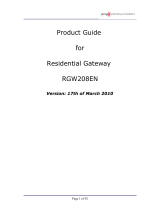
Wireless Controller User Manual
2
Table of Contents
Chapter 1. Introduction ............................................................................................................................. 9
1.1 About this User Manual ............................................................................................ 9
1.2 Typographical Conventions ................................................................................... 10
Chapter 2. Configuring Your Network: ................................................................................................. 11
2.1 LAN Configuration................................................................................................... 11
2.1.1 LAN Configuration in an IPv6 Network ................................................................ 14
2.1.2 Configuring IPv6 Router Advertisements ............................................................ 17
2.2 VLAN Configuration ................................................................................................ 19
2.2.1 Associating VLANs to ports ................................................................................... 20
2.3 Configurable Port: DMZ Setup .............................................................................. 22
2.4 Universal Plug and Play (UPnP) ........................................................................... 23
2.5 Captive Portal .......................................................................................................... 25
2.6 WLAN global configuration .................................................................................... 25
2.6.1 Wireless Discovery configuration ......................................................................... 28
2.6.2 AP Profile Global Configuration ............................................................................ 31
Chapter 3. Connecting to the Internet: WAN Setup ........................................................................... 35
3.1 Internet Setup Wizard ............................................................................................. 35
3.2 WAN Configuration ................................................................................................. 36
3.2.1 WAN Port IP address ............................................................................................. 37
3.2.2 WAN DNS Servers ................................................................................................. 37
3.2.3 DHCP WAN ............................................................................................................. 37
3.2.4 PPPoE ...................................................................................................................... 38
3.2.5 Russia L2TP and PPTP WAN ............................................................................... 41
3.2.6 WAN Configuration in an IPv6 Network ............................................................... 42
3.2.7 Checking WAN Status ............................................................................................ 44
3.3 Features with Multiple WAN Links ........................................................................ 45
3.3.1 Auto Failover ............................................................................................................ 46
3.3.2 Load Balancing ........................................................................................................ 46
3.3.3 Protocol Bindings .................................................................................................... 48
3.4 Routing Configuration ............................................................................................. 49
3.4.1 Routing Mode .......................................................................................................... 49
3.4.2 Dynamic Routing (RIP) .......................................................................................... 52
3.4.3 Static Routing .......................................................................................................... 53
3.5 WAN Port Settings .................................................................................................. 54
Chapter 4. Monitoring Status and Statistics ........................................................................................ 56
4.1 System Overview .................................................................................................... 56
4.1.1 Device Status .......................................................................................................... 56
4.1.2 Resource Utilization ................................................................................................ 58
4.2 Traffic Statistics ....................................................................................................... 60
4.2.1 Wired Port Statistics ............................................................................................... 60
4.3 Active Connections ................................................................................................. 61
4.3.1 Sessions through the controller ............................................................................ 61
4.3.2 LAN Clients .............................................................................................................. 63
4.3.3 Active VPN Tunnels ................................................................................................ 63




















